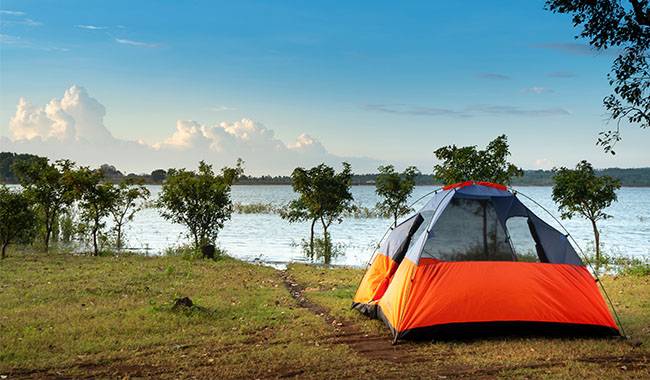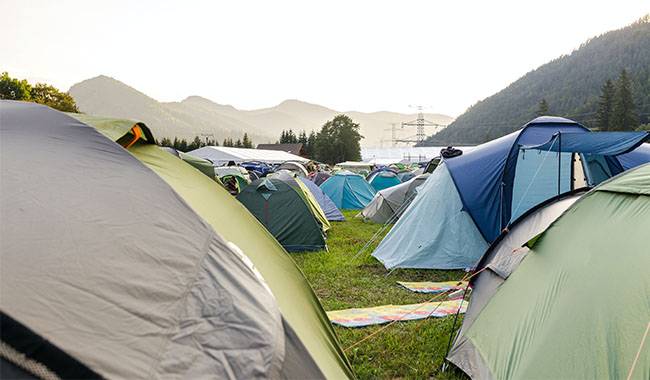
Camping is one of America’s favorite pastimes. It’s an inexpensive and fun way for families and friends to get together and enjoy nature while taking in different parts of the country. Almost all of us have fond childhood memories of camping with family and friends. Sitting around the campfire, roasting marshmallows, telling stories, swimming, hiking, and exploring are some of the most important parts of the camping experience.
That being said, many of us also don’t have such fond memories of enduring pouring rain and gloomy days and nights trapped in damp tents with all of our gear and bedding either wet or completely soaked. Definitely not the greatest camping experience. This is where a sturdy, durable and reliable tent comes into play. It can make or break a camping trip. Thanks to advances in technology, today’s tents are bigger, more durable, and easier to use than ever before. You will learn more about Tents – What Are They Made Of in the LCN Outdoors article.
Modern Tent Materials
A. Tent frame material
Fiberglass
Fiberglass is by far the most common material for economical tent frames. The main advantage of this material, besides its low cost, is that there is almost no permanent deformation of the arched section after bending. However, this is where the advantages end. Fiberglass arcs are subject to strong temperature fluctuations, heat, and cold – which often causes them to split into segments or crumble at the edges along the joints. Compared to aluminum and carbon frames, fiberglass frames are frankly losers in terms of weight and are not easy to repair in the field.
Personal experience has shown that the quality of fiberglass segments is often directly related to the price of the tent. Higher-priced fiberglass segments (mainly used for camping tents) are more durable and flexible than their cheaper counterparts.
Aluminum alloy
The most common frame material for tents in the medium and high price categories is 7000 series aluminum-based deformable alloys. According to the U.S. labeling system, these are aluminum alloys with added zinc and manganese. Initially, they were mainly used in the aerospace industry, for example for the production of fighter planes or aircraft. A characteristic of this combination of alloys is their ability to increase strength during heat treatment. An alloy is denoted by the letter “T” in its markings, for example, “T6” or “T9”. Tubes made from these alloys actually work in the reversible deformation zone to failure.
The most common alloys used to make tent frames are 7001-T6 (usually from DAC or Yunan) and 7075-T9 (from Easton). Occasionally, 6000 series alloys (usually 6061-T6) are used. More rarely used is an aluminum-scandium alloy, which is stronger but slightly heavier. This alloy is produced by the Korean company Yunan and has been used in some tent frames of well-known brands, as well as in high-end tents.
Typically, responsible manufacturers use a deep anodizing process. This means that the aluminum tubes are covered with an oxide film (usually tinted) that protects the metal from scratches and corrosion. This treatment extends the life of the product. The manufacturer’s description of the tent must always include the aluminum alloy used in the tent frame. Otherwise, there is a risk of using a cheap and unreliable counterpart to the proven 7000 series.
The most prominent manufacturers of aluminum tubing used to manufacture tent frames are as follows.
- DAC (“Dongah Aluminum Corporation” – Japan)
- Yunan (Yunan Aluminum Co., LTD – Korea)
- Easton (USA).
A common feature of all their products is.
- High manufacturing precision, so all arc segments are connected reliably.
- High maintainability and durability of the tent arcs.
- Relatively low weight.
- Simple and precise assembly.
Each manufacturer listed, in addition to producing aluminum tent frames, has also contributed to the development of other sports equipment items. For example, in the design and manufacture of hiking poles (DAC), golf clubs (Yunan) and snowshoe frames, and baseball bats (Easton).
The deformation that an aluminum arc may suffer depends not only on the alloy used in it but also on the overall structure of the tent. The structure determines the stiffness and aerodynamic properties of the frame. For example, a half-dome tent is more susceptible to frame tube deformation than a dome tent with the same alloy and the same diameter.
Before you buy a tent, ask your retailer about warranties. Some manufacturers that use frame elements from well-known manufacturers give warranties on arcs. Again, it’s a good idea to find out where you can buy spare parts in case the arches break through your fault.
Carbon fiber
By far the most expensive and exotic tent frame material is a carbon (carbon fiber). The main component of this composite material is carbon fiber. These threads are very thin (about 0.005-0.010 mm in diameter). It is very easy to break them, but quite difficult to tear them. Therefore, such threads are woven into a fabric and then layered at different angles and bonded together with epoxy resin.
Carbon fiber tubes, like glass fiber segments, do not have the residual deformation that aluminum tends to produce after bending. In addition, they are even lighter in weight.
The main drawback for users remains the price of such frames.
By far the oldest player in the carbon fiber tent frame market (since 1999) is Easton. the most famous example of the use of carbon arc is MSR’s Carbon Reflection series of tents.
Frame connectors
In short, buying a tent with a tent arc from a reputable manufacturer is not only a matter of quality. Equally important is the frame assembly process. Leading tent pole manufacturers put a lot of effort into this, providing reliable and simple connecting elements.

B. Fabrics for tents
There are two types of fibers that are used to produce the fabrics used in the tent and canopy industry today.
- Polyester – polyester (polyester)
- Polyamide – nylon (nylon)
Nylon was the first material to find application in modern tent construction (such as the 1974 dome tent), thanks to its lightness and high tensile strength, and abrasion resistance. However, some of its drawbacks were exposed during long-term use, such as low UV resistance, which is particularly noticeable in high-altitude camp conditions, and increased stretching when wet. For this reason, nylon was used exclusively as a material for tent flooring for a long time. It is not threatened by UV degradation and requires a high level of abrasion resistance.
Polyester has long been a leader in the tent industry. It is still preferred by most tent manufacturers unless the goal is to minimize the weight of the tent. Although polyester is slightly heavier than nylon, it is less susceptible to UV radiation and hardly stretches when wet.
C. Waterproofing of awnings
Two materials are used as coatings to make fabrics waterproof
- Polyurethane (PU)
- Silicone (Si)
Polyurethane treatment is applied on the inside of the material. Compared to silicone treatment, it is less expensive to produce but slightly heavier and has similar water resistance.
A characteristic of silicone is its ability to penetrate the fibers of the fabric, making it more resistant to tearing and increasing its resistance to UV radiation, without a critical increase in weight.
The use of silicone has led many manufacturers to turn to nylon for many tent awnings. The double-sided silicone processing deprives him of an inherent disadvantage. A prominent example is the Kelron material from tent manufacturer Hilleberg.
Unfortunately, polyurethane and silicone processing does not make a fabric waterproof indefinitely. The maximum water column pressure that a treated fabric can withstand is measured in millimeters and is stated on the information label of the tent or awning.
A good tent is usually waterproof between 1,500 and 5,000 mm and a floor between 3,000 and 10,000 mm of the water column. This parameter should be seen as a compromise between water-resistance and weight, as each new layer of polyurethane or silicone will not make your tent any lighter.
In addition, the outer surface of the tent and the inner tent can be treated with a waterproof or W/R coating to prevent water from being absorbed into the fabric.
Unfortunately, manufacturers in different countries specify water resistance based on different principles. U.S. tent manufacturers, such as MSR, specify a minimum value for water resistance, even after five years of active use. Many manufacturers state the maximum value of a new tent. Don’t forget that after a few heavy spots of rain, the impregnation may no longer work. Therefore, you must trust the experts in the specialized stores and remember that good thing are never cheap.
D. Fabric properties
When describing the material listed on the tent label, you may encounter the designation “40D” or “210T”. The first indicator is the density of the thread used, marked as D-den or “denier”. The number in front of the letter indicates the weight in grams of a 5.6 mile (9,000 m) length of thread. The larger the number, the greater the density and strength of the thread, but the greater its weight.
The second indicator, T – the number of threads or “tex”, refers to the number of threads in a square inch of fabric, both longitudinal and transverse. The larger the number, the denser the material and the greater the tensile strength.
Ripped. One way to reduce the weight of the material used in a tarp, while maintaining the strength of the tarp, is a ripstop weave. This is a reinforced frame – a particularly strong thread woven into the fabric at 2 to 10 mm intervals to form a characteristic pattern, usually a cage. Most manufacturers strive to make the ripstop weave have the lowest possible profile relative to the base fabric so as not to interfere with the uniform application of the moisture-resistant treatment. So if you can feel dense yarns with your fingers, you’re not talking about a quality fabric.

E. Flame retardant impregnation
A distinctive feature of most modern tents and awnings made by industry-leading brands (The North Face, etc.) is the use of flame retardant impregnants in the fabric. However, manufacturers still prohibit the use of naked flames near or inside the tent. Understandably, prolonged contact with fire can cause the coating to melt or still cause a fire. However, if it is necessary to cook in the vestibule of your mobile home, safety is improved.
F. Netting, accessories and ……
As you know, “the devil is in the small stuff”. You need to pay special attention to these when choosing a mobile home.
Mosquito nets used to make modern indoor tents typically have a mesh density close to 1,000 per square inch. This is enough to protect you not only from mosquitoes and mold but also from small blood-sucking insects, such as mosquitoes. In addition, such a dense mesh will not interfere with your vision. It is relatively expensive to produce, so this net is not usually used in cheap imitation tents.
Plastic accessories for mid-priced or high-priced tents are usually ordered from the European company National Molding, known for Duraflex Plastic Buckles by National Molding. Under this brand, particularly strong and durable nylon-based plastic products are produced. Special additives in the plastic make it resistant to temperature fluctuations, saltwater, and severe frosts.
Special attention is given to zippers, as they are almost impossible to repair by yourself. It is difficult to find a zipper of the right length, and even more difficult to sew it in. For this reason, zippers from YKK Japan are used in the production of technical clothing and intents.
The straps of a good tent are made of polyester, making wise use of its property of not stretching when wet. Very often, reflective fibers are incorporated into very dense webbing to increase visibility at night. Inexpensive tents are often equipped with straps that can be easily pulled off by hand at the store. In the field, low-quality tent straps can cause serious problems with constantly pulling up sagging tent straps. This is especially unpleasant at night and in bad weather.